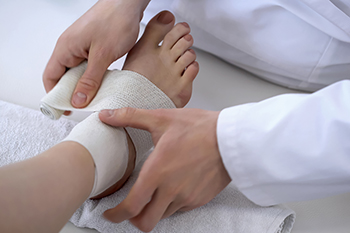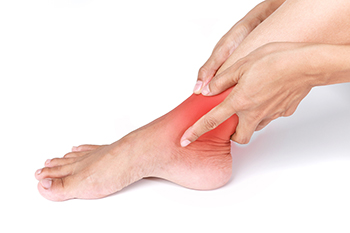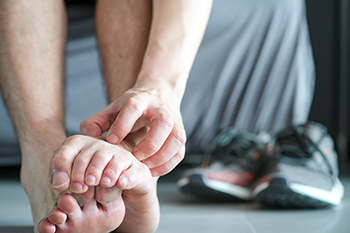Connect With Us
Blog
Items filtered by date: April 2022
Ankle Sprains and Strains: Similar but Different

The words sprain and strain are very similar. So too, are several symptoms of an ankle sprain and ankle strain. Ankle sprains involve the ligaments which hold the bones of the ankle together and support it, while strains involve ankle muscles, often where the muscle attaches to a tendon. In a sprain, the pain is immediate and there may be bruising, while pain from a strain can sometimes come on gradually and a bruise is typically not visible. Both injuries can produce localized swelling, inflammation, and redness. Yet, there may be a noise—an audible popping sound the moment the ligament is injured—in an ankle sprain, which does not occur when you strain the muscles in your ankle. However, you may experience cramps, spasms, or weakness in the muscle when you’ve strained your ankle, which usually doesn’t occur if you’ve sprained the ligaments of your ankle. Both conditions can make it difficult or impossible to move your ankle or to place weight on it. If you are experiencing any type of pain, inflammation, redness, or swelling in your ankles, contact a podiatrist to have your condition properly diagnosed and treated.
Ankle sprains are common but need immediate attention. If you need your feet checked, contact one of our podiatrists from Foot and Ankle Center. Our doctors can provide the care you need to keep you pain-free and on your feet.
How Does an Ankle Sprain Occur?
Ankle sprains take place when the ligaments in your ankle are torn or stretched beyond their limits. There are multiple ways that the ankle can become injured, including twisting or rolling over onto your ankle, putting undue stress on it, or causing trauma to the ankle itself.
What Are the Symptoms?
- Mild to moderate bruising
- Limited mobility
- Swelling
- Discoloration of the skin (depending on severity)
Preventing a Sprain
- Wearing appropriate shoes for the occasion
- Stretching before exercises and sports
- Knowing your limits
Treatment of a Sprain
Treatment of a sprain depends on the severity. Many times, people are told to rest and remain off their feet completely, while others are given an air cast. If the sprain is very severe, surgery may be required.
If you have suffered an ankle sprain previously, you may want to consider additional support such as a brace and regular exercises to strengthen the ankle.
If you have any questions please feel free to contact our office located in Egg Harbor Township, NJ . We offer the newest diagnostic and treatment technologies for all your foot and ankle needs.
Get Professional Care for a Broken Foot or Ankle
Why Your Ankle May Hurt Without an Injury

Ankle pain that is sudden, and not due to an injury, may be caused by any number of causes, including certain arthritic conditions. Rheumatoid arthritis and osteoarthritis can sometimes negatively affect the tissue and cartilage (respectively) in ankles, causing pain and swelling. Similar symptoms can be present when reactive arthritis affects the ankle. This is a condition which is triggered by a bacterial infection elsewhere in the body. Gout is another type of arthritis in which excessive amounts of uric acid crystalize on joints. Gout usually affects the big toe, but it can also affect the ankle. Another disease that sometimes affects the ankle joint causing stiffness, pain and swelling is scleroderma. Bursitis is a condition in which the cushioning bursa sac at the back of the ankle becomes inflamed from stress or overuse and produces pain and inflammation. If you rupture or tear the tendon that connects your calf muscle with your heel (Achilles tendon), you can develop a condition known as Achilles tendonitis. These are just a few of the conditions that may cause ankle pain without injury. Whatever the cause, it is important to have your ankle pain properly diagnosed in order to receive the proper treatment. Call a podiatrist if you are experiencing any pain in your ankle.
Ankle pain can be caused by a number of problems and may be potentially serious. If you have ankle pain, consult with one of our podiatrists from Foot and Ankle Center. Our doctors will assess your condition and provide you with quality foot and ankle treatment.
Ankle pain is any condition that causes pain in the ankle. Due to the fact that the ankle consists of tendons, muscles, bones, and ligaments, ankle pain can come from a number of different conditions.
Causes
The most common causes of ankle pain include:
- Types of arthritis (rheumatoid, osteoarthritis, and gout)
- Ankle sprains
- Broken ankles
- Achilles tendonitis
- Achilles tendon rupture
- Stress fractures
- Bursitis
- Tarsal tunnel syndrome
- Plantar fasciitis
Symptoms
Symptoms of ankle injury vary based upon the condition. Pain may include general pain and discomfort, swelling, aching, redness, bruising, burning or stabbing sensations, and/or loss of sensation.
Diagnosis
Due to the wide variety of potential causes of ankle pain, podiatrists will utilize a number of different methods to properly diagnose ankle pain. This can include asking for personal and family medical histories and of any recent injuries. Further diagnosis may include sensation tests, a physical examination, and potentially x-rays or other imaging tests.
Treatment
Just as the range of causes varies widely, so do treatments. Some more common treatments are rest, ice packs, keeping pressure off the foot, orthotics and braces, medication for inflammation and pain, and surgery.
If you have any questions, please feel free to contact our office located in Egg Harbor Township, NJ . We offer the newest diagnostic and treatment technologies for all your foot care needs.
Athlete’s Foot Can Be Uncomfortable
 A common location for patients to notice athlete's foot is between the toes. The symptoms can be uncomfortable and typically include severe itching, tingling, and possibly small blisters. Other places where athlete’s foot can appear are the bottom or sides of the foot. It is known to be contagious, and the fungus that causes this condition lives and thrives in warm and moist environments. These can include locker rooms, public swimming pools, and shower room floors. It can be spread by sharing towels, socks, and shoes. Additionally, many people wear appropriate shoes while in these types of areas as a preventative measure. If you have athlete’s foot, it is strongly suggested that you are under the care of a podiatrist who can successfully treat this condition.
A common location for patients to notice athlete's foot is between the toes. The symptoms can be uncomfortable and typically include severe itching, tingling, and possibly small blisters. Other places where athlete’s foot can appear are the bottom or sides of the foot. It is known to be contagious, and the fungus that causes this condition lives and thrives in warm and moist environments. These can include locker rooms, public swimming pools, and shower room floors. It can be spread by sharing towels, socks, and shoes. Additionally, many people wear appropriate shoes while in these types of areas as a preventative measure. If you have athlete’s foot, it is strongly suggested that you are under the care of a podiatrist who can successfully treat this condition.
Athlete’s foot is an inconvenient condition that can be easily reduced with the proper treatment. If you have any concerns about your feet and ankles, contact one of our podiatrists from Foot and Ankle Center. Our doctors will treat your foot and ankle needs.
Athlete’s Foot: The Sole Story
Athlete's foot, also known as tinea pedis, can be an extremely contagious foot infection. It is commonly contracted in public changing areas and bathrooms, dormitory style living quarters, around locker rooms and public swimming pools, or anywhere your feet often come into contact with other people.
Solutions to Combat Athlete’s Foot
- Hydrate your feet by using lotion
- Exfoliate
- Buff off nails
- Use of anti-fungal products
- Examine your feet and visit your doctor if any suspicious blisters or cuts develop
Athlete’s foot can cause many irritating symptoms such as dry and flaking skin, itching, and redness. Some more severe symptoms can include bleeding and cracked skin, intense itching and burning, and even pain when walking. In the worst cases, Athlete’s foot can cause blistering as well. Speak to your podiatrist for a better understanding of the different causes of Athlete’s foot, as well as help in determining which treatment options are best for you.
If you have any questions please feel free to contact our office located in Egg Harbor Township, NJ . We offer the newest diagnostic and treatment technologies for all your foot and ankle needs.
Where Is the Cuboid Bone Located?
 The cuboid bone is one of seven tarsal bones that are located in the foot. This particular bone is found on the outside of the foot, near the front of the ankle, and this is where pain is felt when the cuboid bone becomes dislocated. It can happen as a result of enduring a break or sprain, and it often causes pain and discomfort. Relief may be found when the affected area is massaged, and a podiatrist may manipulate the cuboid bone back into its normal position. Some patients find it beneficial to wear specific shoes that can help the foot to feel better, in addition to taping the foot for stability. If you have pain in this part of your foot, it is strongly suggested that you speak with a podiatrist as quickly as possible who can offer you correct treatment solutions for cuboid syndrome.
The cuboid bone is one of seven tarsal bones that are located in the foot. This particular bone is found on the outside of the foot, near the front of the ankle, and this is where pain is felt when the cuboid bone becomes dislocated. It can happen as a result of enduring a break or sprain, and it often causes pain and discomfort. Relief may be found when the affected area is massaged, and a podiatrist may manipulate the cuboid bone back into its normal position. Some patients find it beneficial to wear specific shoes that can help the foot to feel better, in addition to taping the foot for stability. If you have pain in this part of your foot, it is strongly suggested that you speak with a podiatrist as quickly as possible who can offer you correct treatment solutions for cuboid syndrome.
Cuboid syndrome, also known as cuboid subluxation, occurs when the joints and ligaments near the cuboid bone in the foot become torn. If you have cuboid syndrome, consult with one of our podiatrists from Foot and Ankle Center. Our doctors will assess your condition and provide you with quality foot and ankle treatment.
Cuboid syndrome is a common cause of lateral foot pain, which is pain on the outside of the foot. The condition may happen suddenly due to an ankle sprain, or it may develop slowly overtime from repetitive tension through the bone and surrounding structures.
Causes
The most common causes of cuboid syndrome include:
- Injury – The most common cause of this ailment is an ankle sprain.
- Repetitive Strain – Tension placed through the peroneus longus muscle from repetitive activities such as jumping and running may cause excessive traction on the bone causing it to sublux.
- Altered Foot Biomechanics – Most people suffering from cuboid subluxation have flat feet.
Symptoms
A common symptom of cuboid syndrome is pain along the outside of the foot which can be felt in the ankle and toes. This pain may create walking difficulties and may cause those with the condition to walk with a limp.
Diagnosis
Diagnosis of cuboid syndrome is often difficult, and it is often misdiagnosed. X-rays, MRIs and CT scans often fail to properly show the cuboid subluxation. Although there isn’t a specific test used to diagnose cuboid syndrome, your podiatrist will usually check if pain is felt while pressing firmly on the cuboid bone of your foot.
Treatment
Just as the range of causes varies widely, so do treatments. Some more common treatments are ice therapy, rest, exercise, taping, and orthotics.
If you have any questions, please feel free to contact our office located in Egg Harbor Township, NJ . We offer the newest diagnostic and treatment technologies for all your foot care needs.

